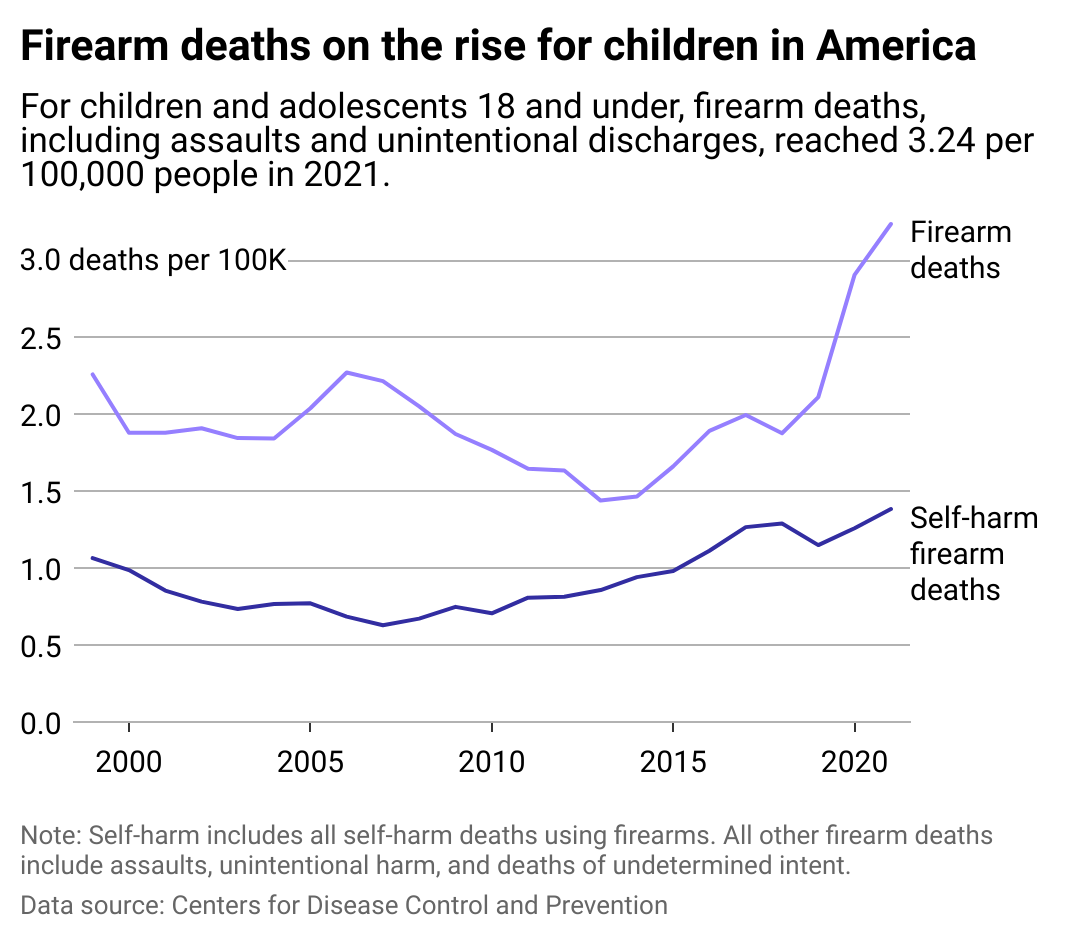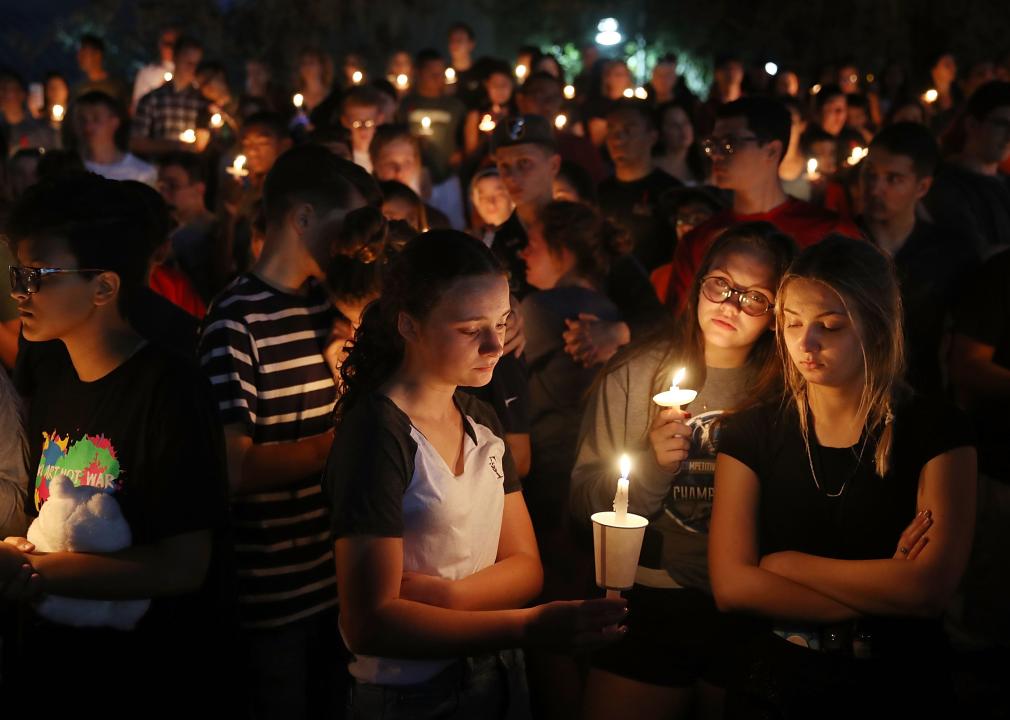New research finds young gun violence survivors experience lasting physical and mental trauma
Joe Raedle // Getty Images
New research finds young gun violence survivors experience lasting physical and mental trauma
People attend a memorial service for the victims of the shooting at Marjory Stoneman Douglas High School.
As of 2024, firearms are the leading cause of child deaths in the U.S. Through new research from Health Affairs, Northwell Health partnered with Stacker to examine the effects of nonfatal firearm injury on young survivors.
Research on gun violence is finally in a state of resurgence after the Dickey Amendment, passed in 1997 and supported by the National Rifle Association of America, halted such research and funding for over a decade. More research couldn’t come at a better time: Every day in the U.S., 120 people die from firearms, and over 200 are injured by them, according to Centers for Disease Control and Prevention data. National data on nonfatal gun violence injuries aren’t collected in the U.S., making studies particularly difficult.
While mass shootings are a near-constant headline in U.S. media, they only comprise a small portion of all gun-related fatalities, which also include suicide, community violence, domestic violence, intimate partner violence, and hate crimes. An analysis of violence against women in the U.S. from Everytown for Gun Safety Support Fund found that nearly 1 million women living today have experienced an intimate partner either shooting them or shooting at them.
A 2017 study showed that women who have experienced domestic violence are at risk for developing psychological symptoms, including post-traumatic stress disorder, due to their partner’s possession of or access to a gun. After interviewing 1,300 American adults, SurveyUSA found that about 3 in 5 (59%) either have personally experienced gun violence or know someone who has; 2 in 5 (41%) of these adults said they were traumatized by such violence.
The Health Affairs study found that children and adolescent survivors of firearm injuries experience over twice as many pain disorders, 68% more psychiatric disorders, and a 144% increase in substance use disorders compared to those who did not experience such events. Survivors’ parents also reported increased rates of psychiatric disorders and mental health visits.
In a 2021 study for Congress conducted by the Government Accountability Office, an expert noted whether the violence was interpersonal or self-inflicted can factor into the kind of behavioral health care a survivor needs. Experts also told the GAO that stays of five days or longer in intensive care put patients at risk of developing further physical, cognitive, and psychiatric symptoms, which may require more health care needs after their initial discharge. Some gun violence survivors will need lifelong care, they said.
The effects of gun violence on mental health can include anxiety, depression, and PTSD. Hypervigilance and fear are also commonly present, with some survivors expressing not wanting to leave their homes, according to research published in the Journal of Trauma Nursing.
Survivors with continued experiences of anxiety, depression, and consistent negative thinking grounded in the fear of sudden violence may experience anticipatory stress reactions when reliving the memory of gun violence, such as the fear of being exposed to another shooting through the news. Charles Figley, Ph.D., a professor of social work and director of the Tulane University Traumatology Institute in New Orleans, told Social Work Today that survivors may also adapt to the possibility of experiencing danger again by becoming skilled at staying safe—a practice he attributed to war veterans—such as learning how to interpret noises, faces, and body language. This hypervigilance, as Figley explained, takes a toll on their psychosocial, medical, and mental health.
Despite their needs, survivors often face barriers to accessing care when services are not covered by their insurance, according to the GAO report. An American Academy of Pediatrics study found that more than 3 in 5 (63%) children aged 5 to 17 nonfatally injured by firearms did not receive mental health care services within six months of the shooting, according to an analysis of Medicaid data, which was not included in the scope of the Heath Affairs study. The AAP research also showed that non-Hispanic Black youth were less likely to have any mental health follow-up than non-Hispanic white youth.
The study published in Health Affairs on the consequences of firearm injuries in survivors and the impacts on victims’ family members used commercial insurance data as a foundation for its research, subsequently lacking data on individuals with insurance through the state or federal government. Consequently, the findings underestimate the ripples gun violence creates, according to STAT News. Additionally, this means the findings undercount the impacts of suicide inflicted by a firearm, as most people who die from suicide never reach the hospital, and thus no insurance claim is created.
On the other side of the spectrum, survivors of gun violence may “feel like they’re invincible,” Lauren Magee, an assistant professor of criminal justice and expert on gun violence and its impact at Indiana University–Purdue University Indianapolis, told Scientific American. This effect can cause more risky behavior, such as drug use among teens and adults. Younger survivors may reenact their trauma, called “traumatic play,” Nicole R. Nugent, Ph.D., a professor and research scholar in the Alpert Brown Medical School’s Department of Psychiatry and Human Behavior, told The New York Times.
![]()

Northwell Health
Firearms are the leading cause of death among children
Line chart showing firearm deaths on the rise for children in America. For children and adolescents 18 and under, firearm deaths including assaults and unintentional discharges reached 3.24 per 100,000 people in 2021.
A 2023 study in the journal Pediatrics found that gun-related injuries are the leading cause of death for young people in the U.S., with firearm homicides having a disproportionate impact on Black children. The study, led by researchers at Northwell Health’s Center for Gun Violence Prevention, also found that childhood firearm deaths continued to increase after a spike in 2020 with growing disparities in Southern and Midwestern states. Across the U.S., preparing for the worst has become a way of life for many American children.
In a recorded 2023 talk with Dr. Megan Ranney, dean of the Yale School of Public Health and a leading gun violence researcher and emergency physician, she said she realized her daughter was always wearing sneakers to events. When Ranney asked her why, she said, “You never know when you’re going to have to run.” Ranney’s son also showed her how in preschool they had learned “turtle time,” where one crouches down to take cover and remains quiet.
Studies show that active shooter drills, which now happen in almost all schools, may increase anxiety, stress, and depression symptoms in children and adolescents.
Regardless of whether their child has been exposed to gun violence, parents’ stress levels are also high. A Pew Research Center survey found that about 1 in 3 parents with children in grades K-12 were “very or extremely worried” about a shooting taking place at their children’s school.
The Health Affairs study found mothers and fathers had more than four and five times, respectively, the rate of psychiatric disorders than families who hadn’t experienced gun violence. Siblings of young people who died from gun violence had twice the rate of psychiatric disorders. A lead researcher of the study at Harvard Medical School, Dr. Zirui Song, hypothesized the cause of this finding, telling NBC News: “Siblings may be staying in their rooms on the phone and on the internet, avoiding social interaction, coping in a way that may not be healthy and is less visible to the health care system.”
Mothers were also found to be slightly less likely to see a doctor for routine care following the incident, perhaps neglecting preventative or nonurgent care.
The risk for PTSD symptoms increases as a person relates more strongly to the event or the person injured, called psychological proximity. Thus, not only do familial links to gun violence carry psychological burdens, but physical proximity does too, according to an analysis of 44 school shootings. A study published in JAMA Pediatrics found that children and teens living within four to five blocks of a shooting were more likely than others to use an emergency room for mental health concerns.
The media narrative that mental health issues cause gun violence is oversimplified and overstated, according to research. Rather, according to a large-scale study, the risk of a person living with mental illness becoming a victim of violence is exponentially larger than such an individual committing assault.
Factors that are more closely linked to perpetrating gun violence are having experienced trauma and violence as a child, being a young person and male, living in neighborhoods with higher rates of violence, and exhibiting low levels of impulse control. Importantly, having easy access to a firearm increases the risk of firearm injuries, particularly in the home, and increases the risk of suicide deaths in children and adolescents.
In 2017, there were 67 million more guns owned by civilians than people in the U.S., according to Small Arms Survey data. According to Pew, about 2 in 5 American adults live in a household with a gun, and the most recent survey of its kind on firearm storage practices in the U.S. found that 4.6 million children live in homes with at least one unlocked and loaded firearm.
Between January 2019 and April 2021, over 7 million Americans bought firearms for the first time. Americans are becoming armed as the country becomes more deeply divided and gun violence becomes more commonplace. Some buy because they know others have them too. But in high-violence communities, it’s more likely that people own firearms because they feel unsafe, expect to become victims, or doubt the police will protect them, according to Arizona State University’s Jesenia Pizarro, Ph.D., an associate professor of criminology and criminal justice, in an interview with Social Work Today. “It becomes a never-ending cycle. Violence begets more violence,” Pizarro said.
The links between easier access to guns, greater numbers of gun purchases, and increases in gun deaths are starkly illustrated in an analysis by The Washington Post.
Overall, while the study published in Health Affairs offers a pixelated picture of the many harms afflicted by firearms, it’s still major progress for advocates and researchers in the field since the impact of the Dickey Amendment lifted. Dr. Ranney told STAT News: “In the mid-2000s, you could not find the word firearm or gun on the Centers for Disease Control and Prevention webpage. … We’ll be able to measure and see whether we actually made a difference, which will lead to more research and hopefully to improvements in outcomes.”
Story editing by Shannon Luders-Manuel. Copy editing by Paris Close. Photo selection by Clarese Moller.
This story originally appeared on Northwell Health and was produced and
distributed in partnership with Stacker Studio.






